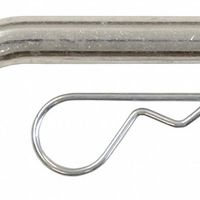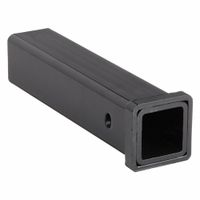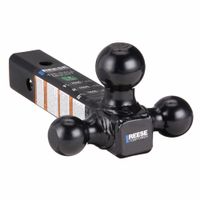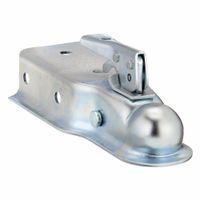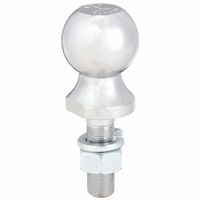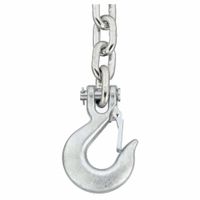Call +(254) 703 030 000 / 751 483 999 / 721 704 777
- Home
- Fleet Vehicle Maintenance
- Towing Trailer Equipment
- Vehicle To Trailer Connection
Vehicle to Trailer Connection
Depending on the type of trailer used, common connections include a variety of hitches, receiver tubes, hitch pins, ball mounts, couplers and chains. Hitches bolt to the chassis of vehicles to connect trailers and other extensions. Receiver tubes attach to the front of vehicles needing to be towed t .....Read More
Frequently Asked Questions
What are the different types of trailer hitches?
There are several types of trailer hitches, each designed for specific towing needs:
1. **Receiver Hitch**: The most common type, it features a square receiver tube and is categorized into five classes based on weight capacity:
- **Class I**: Light-duty, up to 2,000 lbs.
- **Class II**: Medium-duty, up to 3,500 lbs.
- **Class III**: Heavy-duty, up to 8,000 lbs.
- **Class IV**: Extra heavy-duty, up to 10,000 lbs.
- **Class V**: Super heavy-duty, up to 20,000 lbs.
2. **Fifth Wheel Hitch**: Mounted in the bed of a pickup truck, it is used for towing large trailers, such as RVs, with a capacity of up to 30,000 lbs.
3. **Gooseneck Hitch**: Similar to the fifth wheel but uses a ball and coupler system. It is also mounted in the truck bed and is used for heavy-duty towing, often in agricultural or industrial settings.
4. **Bumper Hitch**: Attached to the vehicle's bumper, it is suitable for light towing tasks, typically up to 2,000 lbs.
5. **Pintle Hitch**: Common in commercial and agricultural applications, it uses a hook and ring system, allowing for a more flexible connection, ideal for off-road conditions.
6. **Weight Distribution Hitch**: Used with receiver hitches to distribute the tongue weight across the vehicle and trailer axles, improving stability and control.
7. **Front Mount Hitch**: Installed at the front of a vehicle, it is used for tasks like mounting a winch or maneuvering trailers in tight spaces.
8. **Specialty Hitches**: Include options like motorcycle hitches, RV hitches, and custom hitches designed for specific vehicles or towing needs.
How do I choose the right hitch for my trailer?
To choose the right hitch for your trailer, consider the following factors:
1. **Trailer Type and Weight**: Determine the type of trailer (e.g., utility, travel, boat) and its Gross Trailer Weight (GTW). Ensure the hitch can handle the trailer's weight, including cargo.
2. **Vehicle Towing Capacity**: Check your vehicle's owner's manual for its maximum towing capacity. The hitch must not exceed this limit.
3. **Hitch Classes**: Hitches are categorized into classes (I to V) based on weight capacity. Match the hitch class to your trailer's weight:
- Class I: Up to 2,000 lbs
- Class II: Up to 3,500 lbs
- Class III: Up to 8,000 lbs
- Class IV: Up to 10,000 lbs
- Class V: Up to 20,000 lbs
4. **Receiver Size**: Common receiver sizes are 1.25 inches and 2 inches. Ensure compatibility with your trailer's coupler.
5. **Weight Distribution**: For heavy trailers, consider a weight distribution hitch to evenly distribute weight across the vehicle and trailer axles, improving stability.
6. **Sway Control**: If towing a large trailer, a sway control device can prevent trailer sway, enhancing safety.
7. **Installation**: Decide between a bolt-on or weld-on hitch. Bolt-on hitches are easier to install and remove, while weld-on hitches offer a permanent solution.
8. **Accessories**: Consider additional accessories like hitch locks, wiring harnesses, and brake controllers for enhanced functionality and security.
9. **Professional Advice**: Consult with a towing specialist or mechanic to ensure compatibility and safety.
10. **Legal Requirements**: Check local regulations for towing requirements, such as brake systems or additional mirrors.
By evaluating these factors, you can select a hitch that ensures safe and efficient towing.
What is the purpose of a receiver tube in towing?
The purpose of a receiver tube in towing is to serve as a critical component of a vehicle's towing system, providing a secure and standardized connection point for attaching various towing accessories. It is typically a square, hollow steel tube that is mounted to the rear of a vehicle, such as a truck or SUV, as part of a hitch receiver assembly. The receiver tube is designed to accommodate a range of towing accessories, including ball mounts, bike racks, cargo carriers, and other hitch-mounted equipment.
The receiver tube's primary function is to facilitate the attachment of a ball mount, which in turn holds the trailer ball that connects to the trailer's coupler. This setup allows for the safe and efficient transfer of towing forces from the vehicle to the trailer. The receiver tube's standardized dimensions, usually 1.25 inches, 2 inches, or 2.5 inches in width, ensure compatibility with a wide variety of towing accessories, making it a versatile component in towing systems.
Additionally, the receiver tube provides a secure and stable connection, minimizing movement and reducing the risk of detachment during transit. It is engineered to withstand significant towing loads, with its strength and durability being crucial for maintaining safety and performance while towing. The receiver tube also allows for easy installation and removal of towing accessories, offering convenience and flexibility for users who need to switch between different towing setups.
Overall, the receiver tube is an essential element in towing, ensuring a reliable connection between the towing vehicle and the trailer, thereby enhancing safety, functionality, and versatility in towing operations.
How do hitch pins work in securing trailers?
Hitch pins are essential components in securing trailers to towing vehicles. They work by locking the trailer's coupler to the tow vehicle's hitch, ensuring a stable and secure connection. Here's how they function:
1. **Design and Structure**: Hitch pins are typically made of durable metal, often steel, and consist of a straight pin with a handle or grip on one end and a hole for a retaining clip on the other. The pin is inserted through aligned holes in the hitch and coupler.
2. **Insertion**: To secure a trailer, the hitch pin is inserted through the holes in the trailer's coupler and the vehicle's hitch receiver. This aligns the trailer with the towing vehicle, allowing for a secure connection.
3. **Locking Mechanism**: Once the pin is inserted, a retaining clip or cotter pin is placed through the hole at the end of the hitch pin. This clip prevents the pin from sliding out during transit, ensuring the trailer remains attached to the vehicle.
4. **Safety and Security**: Hitch pins are designed to withstand significant forces and vibrations encountered during towing. They are crucial for preventing accidental detachment, which could lead to accidents or damage.
5. **Ease of Use**: Hitch pins are simple to use, requiring no special tools for installation or removal. This makes them a convenient choice for quickly securing or detaching trailers.
6. **Variety**: There are various types of hitch pins, including locking hitch pins that offer additional security by requiring a key to remove, reducing the risk of theft.
In summary, hitch pins are vital for safely securing trailers to towing vehicles, providing a reliable and straightforward method to ensure the trailer remains attached during transport.
What is the difference between a ball mount and a trailer coupler?
A ball mount and a trailer coupler are both essential components in towing systems, but they serve different functions and are located on different parts of the towing setup.
A ball mount is a component that attaches to the hitch receiver on the towing vehicle. It consists of a metal bar with a platform that holds the hitch ball. The ball mount can be inserted into the hitch receiver and secured with a pin and clip. Ball mounts come in various sizes and configurations, including different drop or rise heights, to ensure the trailer is level when towed. The hitch ball, which is part of the ball mount, is the pivot point for the trailer, allowing it to turn and move with the towing vehicle.
On the other hand, a trailer coupler is a component located on the trailer itself. It is designed to latch onto the hitch ball on the towing vehicle's ball mount. The coupler has a locking mechanism that secures it to the hitch ball, ensuring the trailer is safely connected to the towing vehicle. Trailer couplers come in different sizes to match the diameter of the hitch ball, commonly 1-7/8", 2", or 2-5/16". The coupler allows for the necessary articulation between the trailer and the towing vehicle, accommodating turns and changes in terrain.
In summary, the ball mount is part of the towing vehicle's hitch system, providing the connection point for the trailer, while the trailer coupler is part of the trailer, designed to securely attach to the ball mount's hitch ball. Together, they form the critical link that allows for safe and effective towing.
How do safety chains enhance towing security?
Safety chains enhance towing security by providing a critical backup connection between the towing vehicle and the trailer. In the event of a hitch failure or disconnection, these chains prevent the trailer from completely detaching, thereby reducing the risk of accidents. They are designed to catch the trailer and keep it attached to the towing vehicle, allowing the driver to safely bring both vehicles to a stop.
The chains are typically crossed under the trailer tongue, forming a cradle that supports the trailer if it becomes unhitched. This crossing method helps maintain control and alignment, preventing the trailer from swaying or veering into other lanes of traffic. By keeping the trailer aligned with the towing vehicle, safety chains minimize the potential for collisions with other vehicles or roadside obstacles.
Safety chains are made from durable materials like steel, ensuring they can withstand significant stress and weight. They are equipped with hooks or connectors that securely attach to designated points on both the trailer and the towing vehicle. Proper installation and maintenance of these chains are crucial; they should be the correct length to allow for turning and maneuvering without dragging on the ground, which could cause wear or breakage.
In addition to providing a physical connection, safety chains also serve as a visual reminder for drivers to check their towing setup before each trip. Ensuring that the chains are properly attached and in good condition is a key step in pre-tow inspections, promoting overall towing safety. By acting as a fail-safe mechanism, safety chains significantly enhance the security and reliability of towing operations.
How do I properly install a trailer hitch on my vehicle?
1. **Select the Right Hitch**: Choose a hitch compatible with your vehicle's make, model, and year. Consider the towing capacity and class of the hitch.
2. **Gather Tools and Materials**: You’ll need a socket set, torque wrench, safety glasses, drill (if required), and the hitch kit.
3. **Prepare the Vehicle**: Park on a level surface and engage the parking brake. If necessary, raise the vehicle using a jack and secure it with jack stands.
4. **Remove Obstructions**: If applicable, remove any underbody panels, spare tire, or existing hardware that may obstruct the installation.
5. **Position the Hitch**: Align the hitch with the pre-drilled holes in the vehicle’s frame. You may need assistance to hold the hitch in place.
6. **Insert Bolts**: Insert the provided bolts through the hitch and into the frame. Hand-tighten them to ensure proper alignment.
7. **Torque the Bolts**: Using a torque wrench, tighten the bolts to the manufacturer’s specified torque settings. This ensures the hitch is securely attached.
8. **Reattach Components**: Reinstall any parts removed earlier, such as the spare tire or underbody panels.
9. **Install Electrical Wiring**: If towing a trailer with lights, install a wiring harness. Connect it to the vehicle’s electrical system following the instructions provided.
10. **Test the Installation**: Check the hitch for stability. Ensure all bolts are tight and the hitch is secure. Test the electrical connections with a trailer or tester.
11. **Final Inspection**: Double-check all components and connections. Ensure the hitch is level and properly aligned.
12. **Safety Check**: Before towing, verify the hitch and vehicle can handle the intended load. Check local regulations for any additional requirements.
